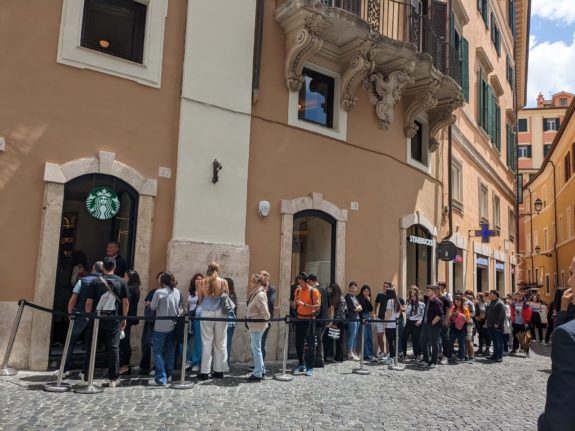Starbucks and supermarket sugo: Is Italian food getting more 'American'?

As Starbucks expands into southern Italy and stores stock a rising number of convenience foods, Silvia Marchetti asks: is the country seeing an inevitable shift towards a more industrialised, American-style diet?
I’m shocked each time I go to the supermarket in Italy and see people buying heaps of canned ragù: all sorts of sugo al pomodoro, pesto con aglio or senza aglio (with or without garlic), and ready-to-serve lasagne and fettuccine.
I know these convenience foods have always been around but they never really caught my attention, probably because they were no big deal up until a few years ago.
Lately, there seem to be more of them on supermarket shelves, and a great variety to satisfy all palates: tomato sauces with vegetables and chicken, rabbit and olives, beans and onions, and vegan mixes.
I notice it’s mostly young people who buy them, and I can’t help but fear that this might be the future, or the end, of traditional Italian cuisine.
People don’t have time to cook after a hard working day, and this is perfectly understandable but in a country where nonna’s recipes have always been the pillar of culinary culture it’s frightening.
READ ALSO: 'One for every district': Starbucks begins southern expansion in central Rome
I’m aware the Italian supermarket offering of canned sauces and ready meals may seem limited to American and British people, but Italy could soon catch up if eating habits become more industrialised, and an unrestrained attitude towards junk food takes over.

Supermarket shoppers in Italy are faced with an ever-growing selection of processed foods. (Photo by Miguel MEDINA / AFP)
Ordering take-out food is now commonplace. According to a report by the Eurispes think tank, just over 70 percent of Italians buy takeaway food while 54 percent opt for home delivery.
Also very common is the habit of buying industrial products at the supermarket that take a few minutes to cook or heat in the microwave or oven (61.9 percent). In all these cases the largest share of consumers are young people aged 18-24.
READ ALSO: Why claims Italian cuisine is a ‘modern invention’ have angered Italy
Another survey by online food operator Everly that tracks purchases made via the web or app on its platform found that compared to 2020 the purchase of ready-to-use sauces in Italy increased in 2021 by 10 percent.
When I see my friends heat frozen lasagne in the microwave, my stomach churns in disgust. If I ever did that, my granny would turn over in her grave. She used to prepare handmade gnocchi curling them with a fork and two types of lasagne (red with tomato and white with just spinach) each weekend. For hours she’d knead the dough to cut out flat, fine strips of tagliatelle.

More french fries, less handmade tagliatelle - to what extent is Italy adopting 'American-style' eating habits? (Photo by JULIEN DE ROSA / AFP)
I am picky, I’ve never bought extra virgin olive oil at the supermarket - it tastes like water - only from local farmers near my place who have tiny olive groves. Theirs is so tasty that I don’t need to add salt to my dishes.
But it’s not just a supermarket frenzy conquering Italian dinner tables. It surely depends on personal tastes, however Italian families are also feeling the pull of non-Italian cuisine sold close to their doorsteps. Italians are adapting to food globalisation.
Starbucks is now expanding in Rome and southern Italy. When Starbucks opened its first shop in Milan a few years ago I thought it would not last long, but I was wrong.
The success of such foreign chain foods in Italy, like McDonald’s (the one at the Spanish Steps is always crammed with Roman teenagers) seems to be getting stronger. It’s not only because of the products they serve, particularly for French fries and hamburger addicts, it’s what they symbolise that attracts customers - the immaterial power of the American brand.

Customers queue outside the new Starbucks branch in central Rome shortly after it opened on Thursday, May 11th. Photo: Elaine Allaby/The Local Italy
Sitting at Starbucks and tasting a frappuccino made US-style, even if a far cry from the real Italian cappuccino, is like indulging in an imported American lifestyle for ten minutes.
And it’s not only teenagers: customers include young adults, professionals who stop by at lunch break, and ladies who meet for ‘evening tea’. These non-Italian foods are still seen as a cool novelty and fad, but could soon become a regular part of more peoples’ diets.
The only antidote to this Americanization of Italian food is through the preservation of culinary culture. Italians must remain anchored to their family homemade recipes passed down across generations, and keep searching for genuine products with certified food origin and zero miles.
READ ALSO: Why do Italians get so angry if you mess with classic recipes?
That’s the only way to counteract this trend, but if nonnas and mammas die without having passed on to their stressed-out workaholic nieces and daughters ‘l’amore per i fornelli’ as my dear auntie used to say (literally ‘the love of stoves’, meaning ‘a passion for cooking’), then it will be the end of what makes Italian cuisine unique in the world.
If you lose the culture behind the food, you lose the food.
Only die-hard purist restaurants and old trattorias will be left to defend the authenticity and identity of Italy’s centuries-old culinary heritage - until they too, will disappear.
Comments (2)
See Also
I’m shocked each time I go to the supermarket in Italy and see people buying heaps of canned ragù: all sorts of sugo al pomodoro, pesto con aglio or senza aglio (with or without garlic), and ready-to-serve lasagne and fettuccine.
I know these convenience foods have always been around but they never really caught my attention, probably because they were no big deal up until a few years ago.
Lately, there seem to be more of them on supermarket shelves, and a great variety to satisfy all palates: tomato sauces with vegetables and chicken, rabbit and olives, beans and onions, and vegan mixes.
I notice it’s mostly young people who buy them, and I can’t help but fear that this might be the future, or the end, of traditional Italian cuisine.
People don’t have time to cook after a hard working day, and this is perfectly understandable but in a country where nonna’s recipes have always been the pillar of culinary culture it’s frightening.
READ ALSO: 'One for every district': Starbucks begins southern expansion in central Rome
I’m aware the Italian supermarket offering of canned sauces and ready meals may seem limited to American and British people, but Italy could soon catch up if eating habits become more industrialised, and an unrestrained attitude towards junk food takes over.

Ordering take-out food is now commonplace. According to a report by the Eurispes think tank, just over 70 percent of Italians buy takeaway food while 54 percent opt for home delivery.
Also very common is the habit of buying industrial products at the supermarket that take a few minutes to cook or heat in the microwave or oven (61.9 percent). In all these cases the largest share of consumers are young people aged 18-24.
READ ALSO: Why claims Italian cuisine is a ‘modern invention’ have angered Italy
Another survey by online food operator Everly that tracks purchases made via the web or app on its platform found that compared to 2020 the purchase of ready-to-use sauces in Italy increased in 2021 by 10 percent.
When I see my friends heat frozen lasagne in the microwave, my stomach churns in disgust. If I ever did that, my granny would turn over in her grave. She used to prepare handmade gnocchi curling them with a fork and two types of lasagne (red with tomato and white with just spinach) each weekend. For hours she’d knead the dough to cut out flat, fine strips of tagliatelle.

I am picky, I’ve never bought extra virgin olive oil at the supermarket - it tastes like water - only from local farmers near my place who have tiny olive groves. Theirs is so tasty that I don’t need to add salt to my dishes.
But it’s not just a supermarket frenzy conquering Italian dinner tables. It surely depends on personal tastes, however Italian families are also feeling the pull of non-Italian cuisine sold close to their doorsteps. Italians are adapting to food globalisation.
Starbucks is now expanding in Rome and southern Italy. When Starbucks opened its first shop in Milan a few years ago I thought it would not last long, but I was wrong.
The success of such foreign chain foods in Italy, like McDonald’s (the one at the Spanish Steps is always crammed with Roman teenagers) seems to be getting stronger. It’s not only because of the products they serve, particularly for French fries and hamburger addicts, it’s what they symbolise that attracts customers - the immaterial power of the American brand.

Sitting at Starbucks and tasting a frappuccino made US-style, even if a far cry from the real Italian cappuccino, is like indulging in an imported American lifestyle for ten minutes.
And it’s not only teenagers: customers include young adults, professionals who stop by at lunch break, and ladies who meet for ‘evening tea’. These non-Italian foods are still seen as a cool novelty and fad, but could soon become a regular part of more peoples’ diets.
The only antidote to this Americanization of Italian food is through the preservation of culinary culture. Italians must remain anchored to their family homemade recipes passed down across generations, and keep searching for genuine products with certified food origin and zero miles.
READ ALSO: Why do Italians get so angry if you mess with classic recipes?
That’s the only way to counteract this trend, but if nonnas and mammas die without having passed on to their stressed-out workaholic nieces and daughters ‘l’amore per i fornelli’ as my dear auntie used to say (literally ‘the love of stoves’, meaning ‘a passion for cooking’), then it will be the end of what makes Italian cuisine unique in the world.
If you lose the culture behind the food, you lose the food.
Only die-hard purist restaurants and old trattorias will be left to defend the authenticity and identity of Italy’s centuries-old culinary heritage - until they too, will disappear.
Join the conversation in our comments section below. Share your own views and experience and if you have a question or suggestion for our journalists then email us at [email protected].
Please keep comments civil, constructive and on topic – and make sure to read our terms of use before getting involved.
Please log in here to leave a comment.